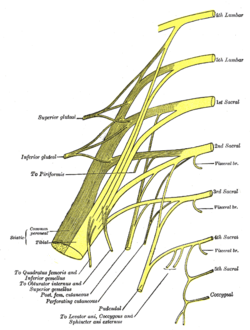Inferior gluteal nerve
| Inferior gluteal nerve | |
|---|---|

Plan of sacral and pudendal plexuses (inferior gluteal nerve labeled at middle left)
|
|

The gluteus medius and nearby muscles
|
|
| Details | |
| From | Sacral plexus (L5–S2) |
| Innervates | Gluteus maximus |
| Identifiers | |
| Latin | Nervus gluteus inferior |
| Dorlands /Elsevier |
n_05/12565853 |
| TA | A14.2.07.032 |
| FMA | 16511 |
|
Anatomical terms of neuroanatomy
[]
|
|
The inferior gluteal nerve is the main motor neuron that innervates the gluteus maximus muscle. It is responsible for the movement of the gluteus maximus in activities requiring the hip to extend the thigh, such as climbing stairs. Injury to this nerve is rare but often occurs as a complication of posterior approach to the hip during hip replacement. When damaged, one would develop gluteus maximus lurch, which is a abnormality which causes the individual to 'lurch' backwards to compensate lack in hip extension.
The largest muscle of the posterior hip, gluteus maximus, is innervated by the inferior gluteal nerve. It branches out and then enters the deep surface of the gluteus maximus, the principal extensor of the thigh, and supplies it.
The muscle is supplied by the inferior gluteal nerve which arises from the dorsal branches of the ventral rami of the fifth (L5), the first (S1) and second (S2) sacral nerves.
The lumbosacral trunk, which is made up of L5 and a small branch of L4, effectively connects the lumbar and sacral plexuses. The lower branches of the L4 and the L5 nerves enter the sacral plexus.
The sacral plexus is formed by the lumbosacral trunk, the first to third sacral ventral rami, and part of the fourth, the remainder of the last joining the coccygeal plexus. The sacral plexus is formed in the pelvis in front of the piriformis muscle.
The sacral plexus is formed anterior to the piriformis muscle and gives rise to the sciatic nerve, the superior and inferior gluteal nerves, and the pudendal and posterior femoral cutaneous nerves.
...
Wikipedia
